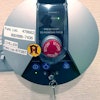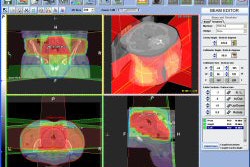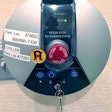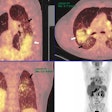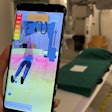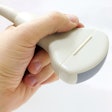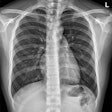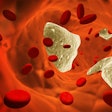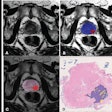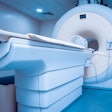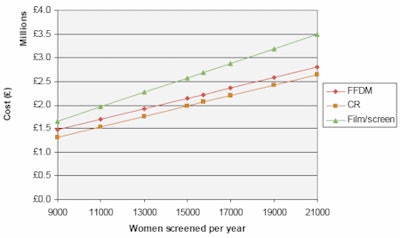
The Digital Mammographic Imaging Screening Trial (DMIST) demonstrated that full-field digital mammography (FFDM) is as effective as analog as a screening tool, and for some women, such as those with dense breasts, the technology is more effective than film-screen in finding cancer.
Despite its clinical stamp of approval, however, many hospitals and imaging facilities find the high cost of FFDM a barrier to its adoption. But FFDM may actually be more cost-effective than analog mammography, according to a report published by the London-based Centre for Evidence-based Purchasing (CEP), an organization that gathers evidence to assist in the adoption of innovative technologies in health and social care.
The report, based on data gathered between 2002 and 2006 via the U.K.'s National Health Service Breast Screening Programme (NHSBSP), compares the workflow and cost-effectiveness of FFDM, computed radiography (CR), and film-screen mammography. Equipment costs were estimated from information provided by suppliers, purchasers, and published reports. The number of women screened at an individual NHSBSP screening unit averaged approximately 16,000 per year, with a six-minute appointment interval framework.
Whole-life cost
Although the initial cost of installing and using FFDM is quite a bit more than an analog unit, many clinical studies on the topic have not considered the whole-life cost of each technology, the report states. FFDM reduces costs by using fewer consumable products and offering the potential for higher throughput.
Full-field digital mammography may also be more cost-effective than CR, the report suggests, but this is dependent upon sufficiently high workloads to create staff time savings by eliminating the processing of CR cassettes.
Whole-life costs for each of the units were estimated over an expected seven-year cycle, according to the report, and they were calculated for an average screening unit at a static, rather than mobile, site and for a range of workloads.
The study found that FFDM is initially slightly more expensive, but the higher storage and consumables cost of film-screen makes it more expensive in the long run. Although CR has a slightly lower whole-life cost than FFDM for all of the workloads the study considered, the report suggests that using FFDM will save on staffing costs.
Whole-life cost for different workloads at a static screening site
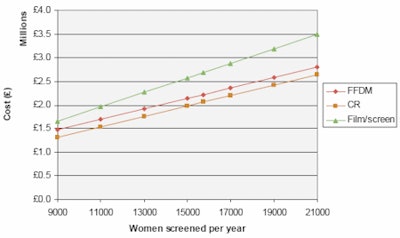 |
| Chart courtesy of the NHS PASA Centre for Evidence-based Purchasing. |
Workflow
The CEP estimated the minimum time it took to produce four images for film-screen and digital mammography. For film-screen, this was the time from introducing the first cassette into the film processor to the fourth film leaving the processor. For CR units, this was the time from introducing the first cassette into the CR reader to the fourth image appearing on the display monitor. Finally, for FFDM, this was the time from the first exposure to the fourth image appearing on the monitor.
The study found that the minimum time to produce four images was as follows:
|
The workflow data indicated that most current CR and FFDM units can handle a six-minute screening appointment framework, and that some systems may be able to operate with shorter appointment intervals. The study also found that for all possible workloads included in the data, analog cost the most per woman screened (about $44, or 25 pounds); FFDM and CR were similar in cost per woman screened across workloads (less than $35, or 20 pounds), with the cost of FFDM moving closer to the cost of CR as workload increased.
By Kate Madden Yee
AuntMinnie.com staff writer
September 11, 2008
Related Reading
FDA issues advisory on FFDM and PACS, July 30, 2008
FDA proposes easier regulatory path for FFDM systems, June 10, 2008
FFDM reimbursement: Money still matters, May 23, 2008
Making dollars and sense out of Medicaid and FFDM reimbursement, December 20, 2007
FFDM makes headway as primary breast cancer screening modality, November 27, 2007
Copyright © 2008 AuntMinnie.com
